Social and Economic Factors of Industrial Carbon Dioxide in China: From the Perspective of Spatiotemporal Transition
Abstract
1. Introduction
2. Methodology and Data
2.1. Methodology
2.1.1. Calculation of CO2 Emission
2.1.2. ESDA Method
2.1.3. LMDI Model
2.2. Sources of Data
3. Analysis of Spatiotemporal Transition
3.1. Regional Distribution of Industrial CO2 Emissions
3.2. Spatial Autocorrelation of Industrial CO2 Emission
3.3. Spatiotemporal Transition of Industrial CO2 Emission
4. LMDI Analysis based on Spatiotemporal Transition
4.1. Driving Factors of National Industrial CO2 Emission
4.2. Variation of Sub-Index Contribution Degree to Different Spatiotemporal Transition Types
4.3. Discussion on Regional CO2 Emission Reduction based on Spatiotemporal Transition Types
5. Conclusions
Author Contributions
Funding
Institutional Review Board Statement
Informed Consent Statement
Data Availability Statement
Conflicts of Interest
References
- Wang, Y.; He, X. Spatial economic dependency in the Environmental Kuznets Curve of carbon dioxide: The case of China. J. Clean. Prod. 2019, 218, 498–510. [Google Scholar] [CrossRef]
- Shi, Y.; Han, B.; Han, L.; Wei, Z. Uncovering the national and regional household carbon emissions in China using temporal and spatial decomposition analysis models. J. Clean. Prod. 2019, 232, 966–979. [Google Scholar] [CrossRef]
- Li, G.; Zakari, A.; Tawiah, V. Energy resource melioration and CO2 emissions in China and Nigeria: Efficiency and trade perspectives. Res. Policy 2020, 68, 101769. [Google Scholar] [CrossRef]
- Li, F.; Cai, B.; Ye, Z.; Wang, Z.; Zhang, W.; Zhou, P.; Chen, J. Changing patterns and determinants of transportation carbon emissions in Chinese cities. Energy 2019, 174, 562–575. [Google Scholar] [CrossRef]
- Li, J.; Li, S. Energy investment, economic growth and carbon emissions in China—Empirical analysis based on spatial Durbin model. Energy Policy 2020, 140, 111425. [Google Scholar] [CrossRef]
- Jiang, J.; Ye, B.; Xie, D.; Tang, J. Provincial-level carbon emission drivers and emission reduction strategies in China: Combining multi-layer LMDI decomposition with hierarchical clustering. J. Clean. Prod. 2017, 169, 178–190. [Google Scholar] [CrossRef]
- Huo, T.; Li, X.; Cai, W.; Zuo, J.; Jia, F.; Wei, H. Exploring the impact of urbanization on urban building carbon emissions in China: Evidence from a provincial panel data model. Sustain. Cities Soc. 2020, 56, 102068. [Google Scholar] [CrossRef]
- Chong, C.H.; Tan, W.X.; Ting, Z.J.; Liu, P.; Ma, L.; Li, Z.; Ni, W. The driving factors of energy-related CO2 emission growth in Malaysia: The LMDI decomposition method based on energy allocation analysis. Renew. Sustain. Energy Rev. 2019, 115, 109356. [Google Scholar] [CrossRef]
- Liu, L.-C.; Fan, Y.; Wu, G.; Wei, Y.-M. Using LMDI method to analyze the change of China’s industrial CO2 emissions from final fuel use: An empirical analysis. Energy Policy 2007, 35, 5892–5900. [Google Scholar] [CrossRef]
- Su, B.; Ang, B.W. Input–output analysis of CO2 emissions embodied in trade: The effects of spatial aggregation. Ecol. Econ. 2010, 70, 10–18. [Google Scholar] [CrossRef]
- Wu, F.; Huang, N.; Zhang, Q.; Qiao, Z.; Zhan, N. Multi-province comparison and typology of China’s CO2 emission: A spatial–temporal decomposition approach. Energy 2020, 190, 116312. [Google Scholar] [CrossRef]
- Cheng, Z.; Li, L.; Liu, J.; Zhang, H. Total-factor carbon emission efficiency of China’s provincial industrial sector and its dynamic evolution. Renew. Sustain. Energy Rev. 2018, 94, 330–339. [Google Scholar] [CrossRef]
- Wang, Q.; Hang, Y.; Zhou, P.; Wang, Y. Decoupling and attribution analysis of industrial carbon emissions in Taiwan. Energy 2016, 113, 728–738. [Google Scholar] [CrossRef]
- Li, L.; Hong, X.; Peng, K. A spatial panel analysis of carbon emissions, economic growth and high-technology industry in China. Struct. Chang. Econ. Dyn. 2019, 49, 83–92. [Google Scholar] [CrossRef]
- Zhang, F.; Deng, X.; Phillips, F.; Fang, C.; Wang, C. Impacts of industrial structure and technical progress on carbon emission intensity: Evidence from 281 cities in China. Technol. Forecast. Soc. Chang. 2020, 154, 119949. [Google Scholar] [CrossRef]
- Chen, L.; Xu, L.; Yang, Z. Inequality of industrial carbon emissions of the urban agglomeration and its peripheral cities: A case in the Pearl River Delta, China. Renew. Sustain. Energy Rev. 2019, 109, 438–447. [Google Scholar] [CrossRef]
- Li, H.; Zhao, Y.; Wang, S.; Liu, Y. Spatial-temporal characteristics and drivers of the regional residential CO2 emissions in China during 2000–2017. J. Clean. Prod. 2020, 276, 124116. [Google Scholar] [CrossRef]
- Liu, H.; Song, Y. Financial development and carbon emissions in China since the recent world financial crisis: Evidence from a spatial-temporal analysis and a spatial Durbin model. Sci. Total Environ. 2020, 715, 136771. [Google Scholar] [CrossRef] [PubMed]
- Zhang, F.; Zhang, Q.; Li, F.; Fu, H.; Yang, X. The spatial correlation pattern of water footprint intensity and its driving factors in China. J. Nat. Resour. 2019, 34, 934–944. [Google Scholar] [CrossRef]
- Wu, G.; Sun, X.; Yu, F.; Yang, L. Spatial correlation pattern and influencing factors of China’s crop production carbon productivity. Chin. J. Popul. Resour. Environ. 2020, 30, 46–57. [Google Scholar] [CrossRef]
- Chen, L.; Xu, L.; Cai, Y.; Yang, Z. Spatiotemporal patterns of industrial carbon emissions at the city level. Resour. Conserv. Recycl. 2021, 169, 105499. [Google Scholar] [CrossRef]
- Zhao, G.; Zhao, G.; Chen, L.; Sun, H. Research on spatial and temporal evolution of carbon emission intensity and its transition mechanism. Chin. J. Popul. Resour. Environ. 2017, 27, 84–93. [Google Scholar] [CrossRef]
- Liu, S.; Xiao, Q. An empirical analysis on spatial correlation investigation of industrial carbon emissions using SNA-ICE model. Energy 2021, 224, 120183. [Google Scholar] [CrossRef]
- Wang, B.; Sun, F.; Wang, Z. Agglomeration effect of CO2 emissions and emissions reduction effect of technology: A spatial econometric perspective based on China’s province-level data. J. Clean. Prod. 2018, 204, 96–106. [Google Scholar] [CrossRef]
- Zheng, H.; Gao, X.; Sun, Q.; Han, X.; Wang, Z. The impact of regional industrial structure differences on carbon emission differences in China: An evolutionary perspective. J. Clean. Prod. 2020, 257, 120506. [Google Scholar] [CrossRef]
- Donglan, Z.; Dequn, Z.; Peng, Z. Driving forces of residential CO2 emissions in urban and rural China: An index decomposition analysis. Energy Policy 2010, 38, 3377–3383. [Google Scholar] [CrossRef]
- Song, Y.; Huang, J.-B.; Feng, C. Decomposition of energy-related CO2 emissions in China’s iron and steel industry: A comprehensive decomposition framework. Resour. Policy 2018, 59, 103–116. [Google Scholar] [CrossRef]
- Zhang, M.; Mu, H.; Ning, Y.; Song, Y. Decomposition of energy-related CO2 emission over 1991–2006 in China. Ecol. Econ. 2009, 68, 2122–2128. [Google Scholar] [CrossRef]
- Zhang, L.; Pang, J.; Chen, X.; Lu, Z. Carbon emissions, energy consumption and economic growth: Evidence from the agricultural sector of China’s main grain-producing areas. Sci. Total Environ. 2019, 665, 1017–1025. [Google Scholar] [CrossRef]
- Yu, J.; Shao, C.; Xue, C.; Hu, H. China’s aircraft-related CO2 emissions: Decomposition analysis, decoupling status, and future trends. Energy Policy 2020, 138, 111215. [Google Scholar] [CrossRef]
- Robaina-Alves, M.; Moutinho, V.; Costa, R. Change in energy-related CO2 (carbon dioxide) emissions in Portuguese tourism: A decomposition analysis from 2000 to 2008. J. Clean. Prod. 2016, 111, 520–528. [Google Scholar] [CrossRef]
- Yang, J.; Cai, W.; Ma, M.; Li, L.; Liu, C.; Ma, X.; Li, L.; Chen, X. Driving forces of China’s CO2 emissions from energy consumption based on Kaya-LMDI methods. Sci. Total Environ. 2020, 711, 134569. [Google Scholar] [CrossRef] [PubMed]
- Lin, B.; Ouyang, X. Analysis of energy-related CO2 (carbon dioxide) emissions and reduction potential in the Chinese non-metallic mineral products industry. Energy 2014, 68, 688–697. [Google Scholar] [CrossRef]
- Ma, M.; Cai, W.; Cai, W. Carbon abatement in China’s commercial building sector: A bottom-up measurement model based on Kaya-LMDI methods. Energy 2018, 165, 350–368. [Google Scholar] [CrossRef]
- Song, Y.; Zhang, M.; Shan, C. Research on the decoupling trend and mitigation potential of CO2 emissions from China’s transport sector. Energy 2019, 183, 837–843. [Google Scholar] [CrossRef]
- Quan, C.; Cheng, X.; Yu, S.; Ye, X. Analysis on the influencing factors of carbon emission in China’s logistics industry based on LMDI method. Sci. Total Environ. 2020, 734, 138473. [Google Scholar] [CrossRef]
- Li, J.; Huang, X.; Wu, C.; Zhou, Y.; Xu, G. Analysis of spatial heterogeneity impact factors on carbon emissions in china. Econ. Geogr. 2015, 35, 21–28. [Google Scholar] [CrossRef]
- Ang, B.W.; Liu, N. Energy decomposition analysis: IEA model versus other methods. Energy Policy 2007, 35, 1426–1432. [Google Scholar] [CrossRef]
- Lin, S.; Zhao, D.; Marinova, D. Analysis of the environmental impact of China based on STIRPAT model. Environ. Impact Assess. Rev. 2009, 29, 341–347. [Google Scholar] [CrossRef]
- Moutinho, V.; Madaleno, M.; Inglesi-Lotz, R.; Dogan, E. Factors affecting CO2 emissions in top countries on renewable energies: A LMDI decomposition application. Renew. Sustain. Energy Rev. 2018, 90, 605–622. [Google Scholar] [CrossRef]
- De Oliveira-De Jesus, P.M. Effect of generation capacity factors on carbon emission intensity of electricity of Latin America & the Caribbean, a temporal IDA-LMDI analysis. Renew. Sustain. Energy Rev. 2019, 101, 516–526. [Google Scholar] [CrossRef]
- Akbostanci, E.; Tunc, G.I.; Turut-Asik, S. CO2 emissions of Turkish manufacturing industry: A decomposition analysis. Appl. Energy 2011, 88, 2273–2278. [Google Scholar] [CrossRef]
- Wang, S.; Zhu, X.; Song, D.; Wen, Z.; Chen, B.; Feng, K. Drivers of CO2 emissions from power generation in China based on modified structural decomposition analysis. J. Clean. Prod. 2019, 220, 1143–1155. [Google Scholar] [CrossRef]
- Wang, W.W.; Zhang, M.; Zhou, M. Using LMDI method to analyze transport sector CO2 emissions in China. Energy 2011, 36, 5909–5915. [Google Scholar] [CrossRef]
- Yuan, R.; Rodrigues, J.F.D.; Behrens, P. Driving forces of household carbon emissions in China: A spatial decomposition analysis. J. Clean. Prod. 2019, 233, 932–945. [Google Scholar] [CrossRef]
- Liu, J. An empirical study on carbon emissions from the perspective of energy efficiency. Doctoral Thesis, Shanghai Academy of Social Sciences, Shanghai, China, 2012. [Google Scholar]
- Zhang, Y.-J.; Liang, T.; Jin, Y.-L.; Shen, B. The impact of carbon trading on economic output and carbon emissions reduction in China’s industrial sectors. Appl. Energy 2020, 260, 114290. [Google Scholar] [CrossRef]
- Wang, Y.; Li, J. Spatial spillover effect of non-fossil fuel power generation on carbon dioxide emissions across China’s provinces. Renew. Energy 2019, 136, 317–330. [Google Scholar] [CrossRef]
- Xu, L.; Du, H.; Zhang, X. Driving forces of carbon dioxide emissions in China’s cities: An empirical analysis based on the geodetector method. J. Clean. Prod. 2020, 125169. [Google Scholar] [CrossRef]
- Shi, K.; Yu, B.; Zhou, Y.; Chen, Y.; Yang, C.; Chen, Z.; Wu, J. Spatiotemporal variations of CO2 emissions and their impact factors in China: A comparative analysis between the provincial and prefectural levels. Appl. Energy 2019, 233–234, 170–181. [Google Scholar] [CrossRef]
- Long, R.; Shao, T.; Chen, H. Spatial econometric analysis of China’s province-level industrial carbon productivity and its influencing factors. Appl. Energy 2016, 166, 210–219. [Google Scholar] [CrossRef]
- Wang, S.; Fang, C.; Wang, Y. Spatiotemporal variations of energy-related CO2 emissions in China and its influencing factors: An empirical analysis based on provincial panel data. Renew. Sustain. Energy Rev. 2016, 55, 505–515. [Google Scholar] [CrossRef]
- Mousavi, B.; Lopez, N.S.A.; Biona, J.B.M.; Chiu, A.S.F.; Blesl, M. Driving forces of Iran’s CO2 emissions from energy consumption: An LMDI decomposition approach. Appl. Energy 2017, 206, 804–814. [Google Scholar] [CrossRef]
- Ang, B.W. The LMDI approach to decomposition analysis: A practical guide. Energy Policy 2005, 33, 867–871. [Google Scholar] [CrossRef]
- Ang, B.W.; Liu, F.L. A new energy decomposition method: Perfect in decomposition and consistent in aggregation. Energy 2001, 26, 537–548. [Google Scholar] [CrossRef]
- Zhang, Y.; Shuai, C.; Bian, J.; Chen, X.; Wu, Y.; Shen, L. Socioeconomic factors of PM2.5 concentrations in 152 Chinese cities: Decomposition analysis using LMDI. J. Clean. Prod. 2019, 218, 96–107. [Google Scholar] [CrossRef]
- Zhang, X.; Zhao, Y.; Wang, C.; Wang, F.; Qiu, F. Decoupling effect and sectoral attribution analysis of industrial energy-related carbon emissions in Xinjiang, China. Ecol. Indic. 2019, 97, 1–9. [Google Scholar] [CrossRef]
- Wen, L.; Li, Z. Provincial-level industrial CO2 emission drivers and emission reduction strategies in China: Combining two-layer LMDI method with spectral clustering. Sci. Total Environ. 2019, 700, 134374. [Google Scholar] [CrossRef]
- Chang, N. Changing industrial structure to reduce carbon dioxide emissions: A Chinese application. J. Clean. Prod. 2015, 103, 40–48. [Google Scholar] [CrossRef]
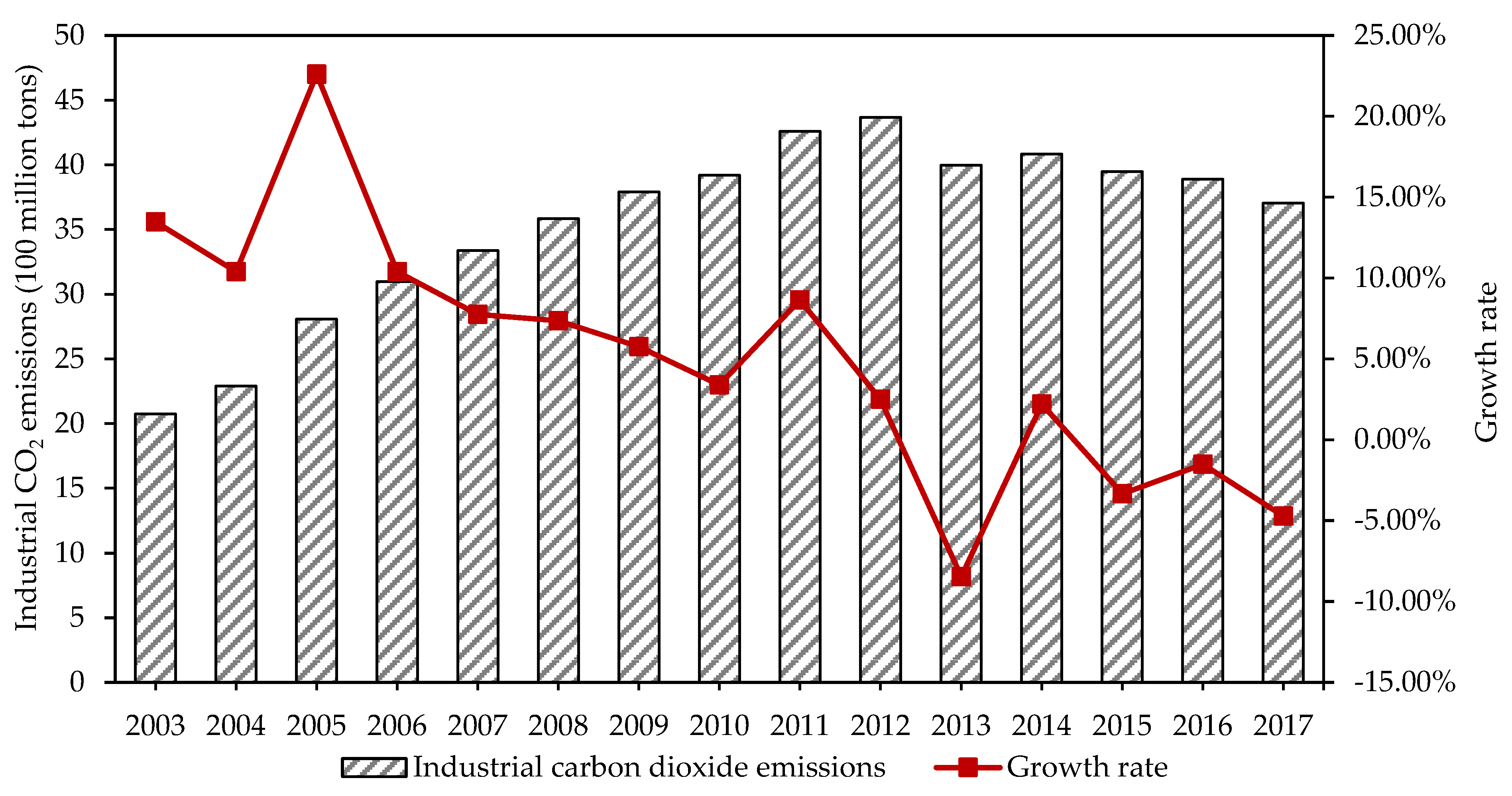
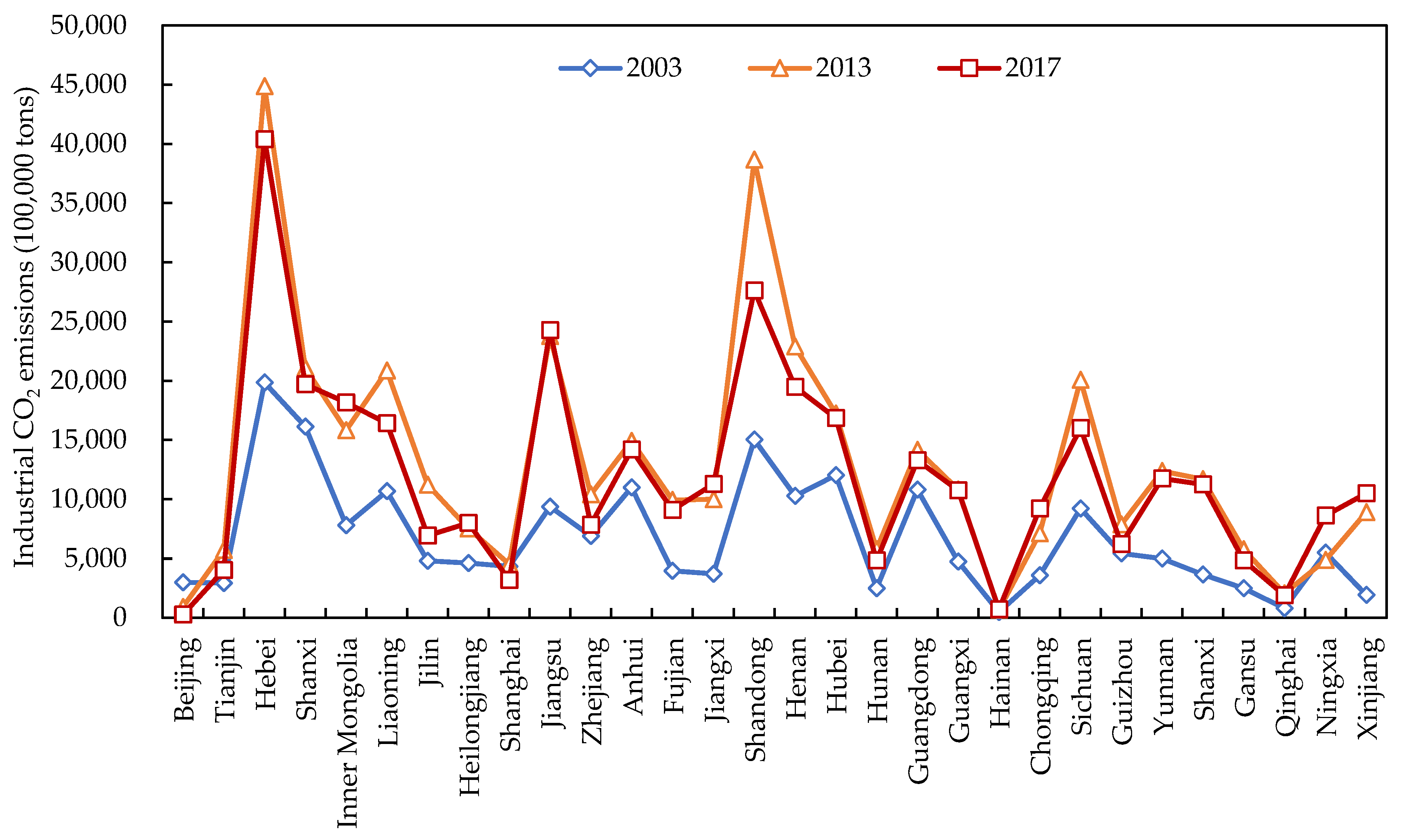
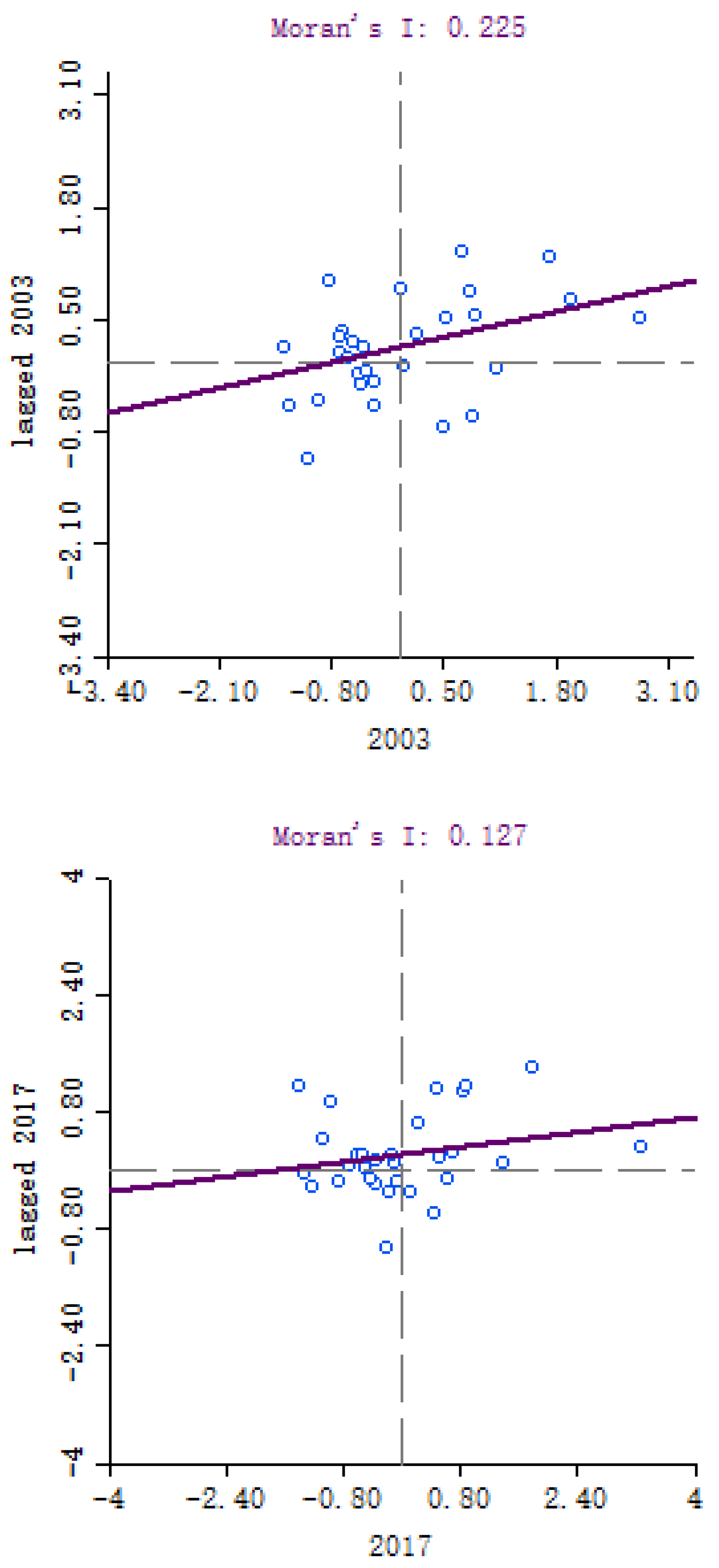
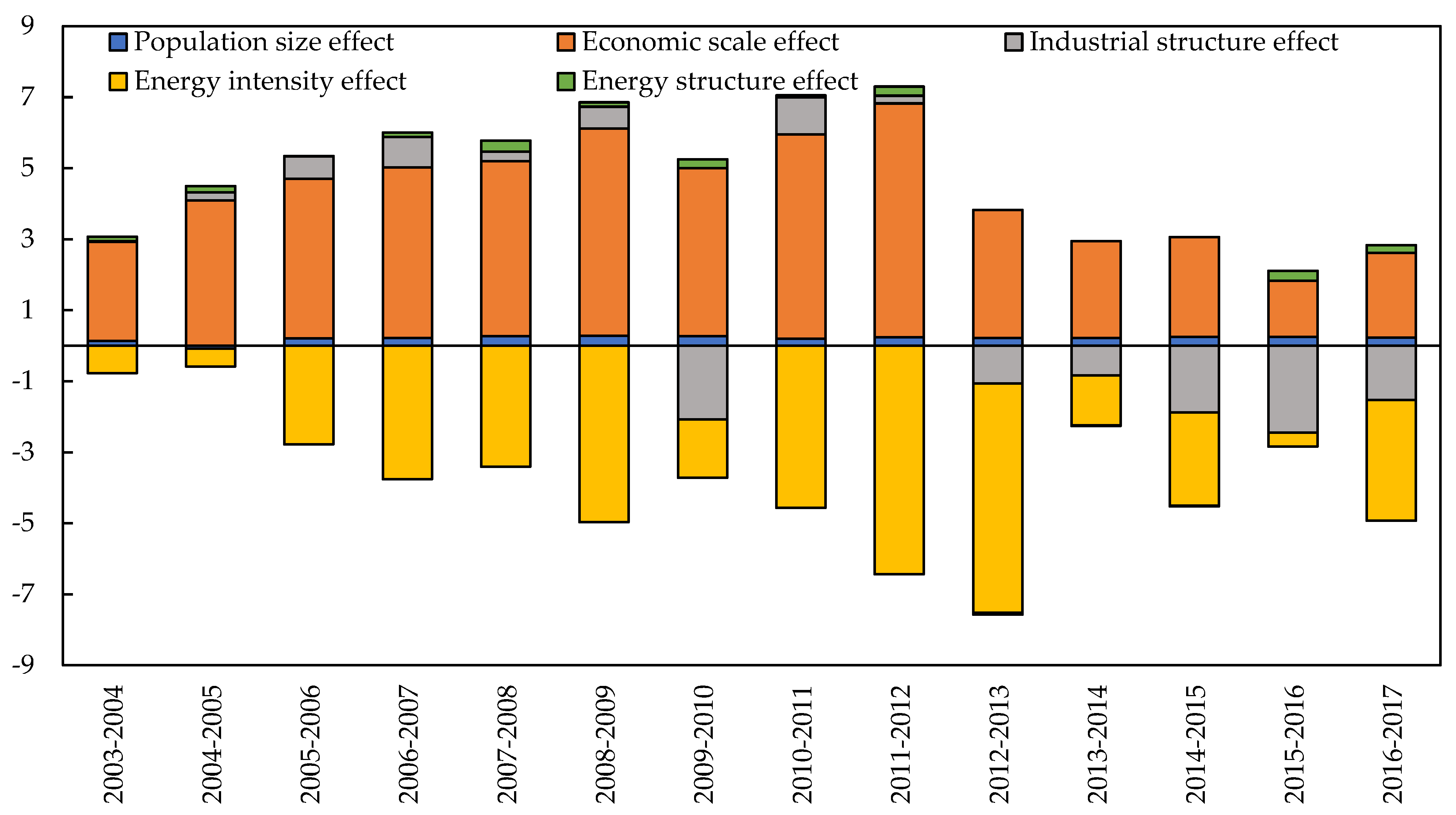
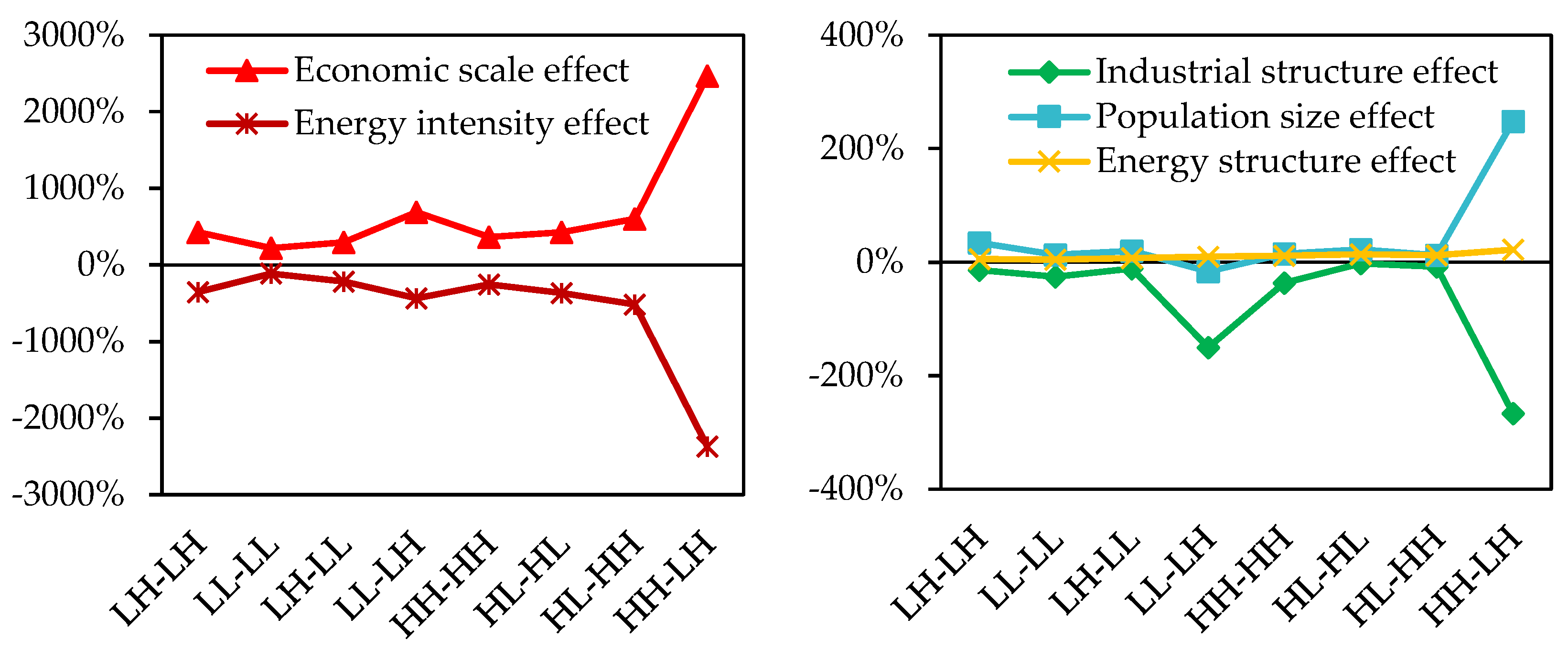
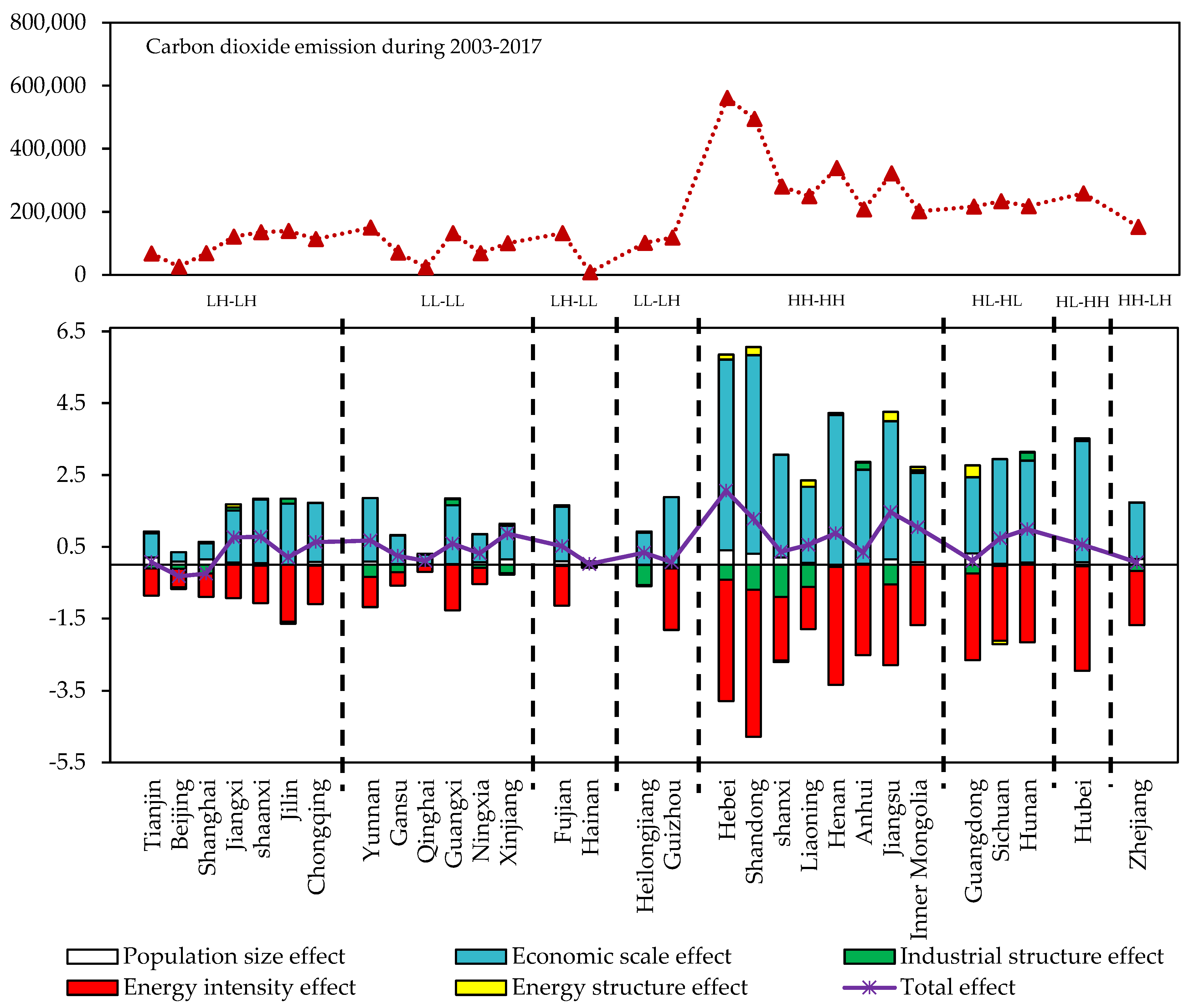
| Coefficient | Coal | Coke | Crude oil | Fuel oil | Kerosene | Diesel oil | Natural Gas |
|---|---|---|---|---|---|---|---|
| ωi(t/tce) | 2.741 | 2.945 | 2.147 | 2.265 | 2.104 | 2.176 | 1.642 |
| Year | Moran’s I | Year | Moran’s I | Year | Moran’s I |
|---|---|---|---|---|---|
| 2003 | 0.225 ** | 2008 | 0.265 *** | 2013 | 0.219 ** |
| 2004 | 0.297 *** | 2009 | 0.244 ** | 2014 | 0.238 ** |
| 2005 | 0.301 *** | 2010 | 0.255 *** | 2015 | 0.203 ** |
| 2006 | 0.293 *** | 2011 | 0.25 ** | 2016 | 0.165 ** |
| 2007 | 0.305 *** | 2012 | 0.182 ** | 2017 | 0.127 * |
| Year | Agglomeration Type | |||
|---|---|---|---|---|
| HH (High-High) | LH (Low-High) | LL (Low-Low) | HL (High-Low) | |
| 2003 | Hebei Shandong Shanxi Liaoning Henan Anhui Jiangsu Zhejiang Inner Mongolia | Tianjin Beijing Shanghai Jiangxi Shaanxi Jilin Hainan Fujian Chongqing | Heilongjiang Yunnan Guizhou Gansu Qinghai Ningxia Xinjiang Guangxi | Guangdong Sichuan Hubei Hunan |
| 2017 | Hebei Shandong Liaoning Henan Anhui Jiangsu Shanxi Hubei Inner Mongolia | Tianjin Beijing Shanghai Jiangxi Shaanxi Jilin Zhejiang Chongqing Guizhou Heilongjiang | Yunnan Gansu Qinghai Ningxia Xinjiang Guangxi Fujian Hainan | Guangdong Sichuan Hunan |
| Type | Spatiotemporal Transition | Provinces | ||
|---|---|---|---|---|
| Transition | Local | Neighborhood | ||
| LH→LH | I | - | - | Tianjin Beijing Shanghai Jiangxi Shaanxi Jilin Chongqing |
| LL→LL | I | - | - | Yunnan Gansu Qinghai Guangxi Ningxia Xinjiang |
| LH→LL | II | - | high→low | Fujian Hainan |
| LL→LH | II | - | low→high | Heilongjiang Guizhou |
| LH→HH | II | low→high | - | - |
| LL→HL | II | low→high | - | - |
| LH→HL | II | low→high | high→low | - |
| LL→HH | II | low→high | low→high | - |
| HH→HH | I | - | - | Hebei Shandong Shanxi Liaoning Henan Anhui Jiangsu Inner Mongolia |
| HL→HL | I | - | - | Guangdong Sichuan Hunan |
| HH→HL | II | - | high→low | - |
| HL→HH | II | - | low→high | Hubei |
| HH→LH | II | high→low | - | Zhejiang |
| HL→LL | II | high→low | - | - |
| HH→LL | II | high→low | high→low | - |
| HL→LH | II | high→low | low→high | - |
Publisher’s Note: MDPI stays neutral with regard to jurisdictional claims in published maps and institutional affiliations. |
© 2021 by the authors. Licensee MDPI, Basel, Switzerland. This article is an open access article distributed under the terms and conditions of the Creative Commons Attribution (CC BY) license (https://creativecommons.org/licenses/by/4.0/).
Share and Cite
Li, J.; Cheng, J.; Diao, B.; Wu, Y.; Hu, P.; Jiang, S. Social and Economic Factors of Industrial Carbon Dioxide in China: From the Perspective of Spatiotemporal Transition. Sustainability 2021, 13, 4268. https://doi.org/10.3390/su13084268
Li J, Cheng J, Diao B, Wu Y, Hu P, Jiang S. Social and Economic Factors of Industrial Carbon Dioxide in China: From the Perspective of Spatiotemporal Transition. Sustainability. 2021; 13(8):4268. https://doi.org/10.3390/su13084268
Chicago/Turabian StyleLi, Jingyuan, Jinhua Cheng, Beidi Diao, Yaqi Wu, Peiqi Hu, and Shurui Jiang. 2021. "Social and Economic Factors of Industrial Carbon Dioxide in China: From the Perspective of Spatiotemporal Transition" Sustainability 13, no. 8: 4268. https://doi.org/10.3390/su13084268
APA StyleLi, J., Cheng, J., Diao, B., Wu, Y., Hu, P., & Jiang, S. (2021). Social and Economic Factors of Industrial Carbon Dioxide in China: From the Perspective of Spatiotemporal Transition. Sustainability, 13(8), 4268. https://doi.org/10.3390/su13084268






